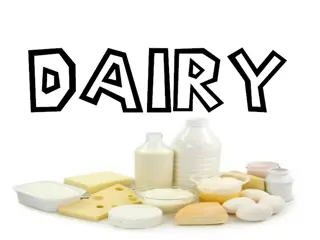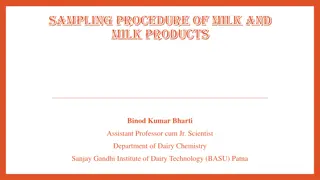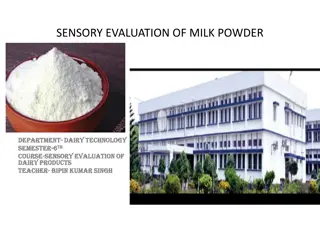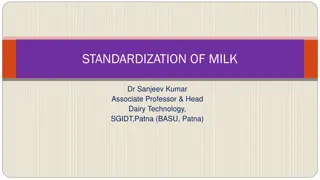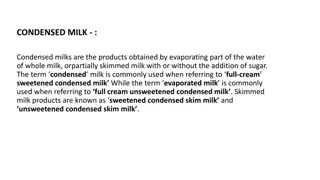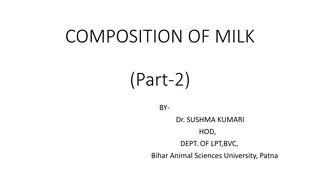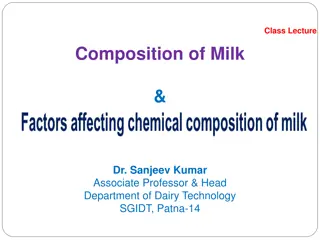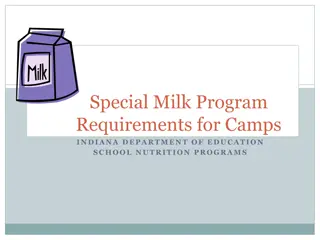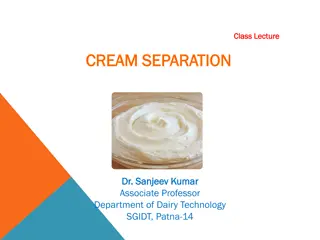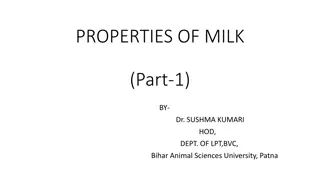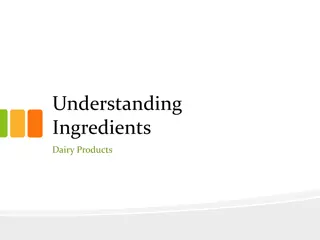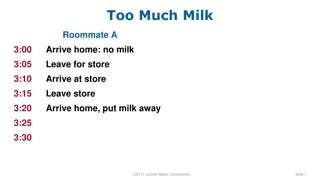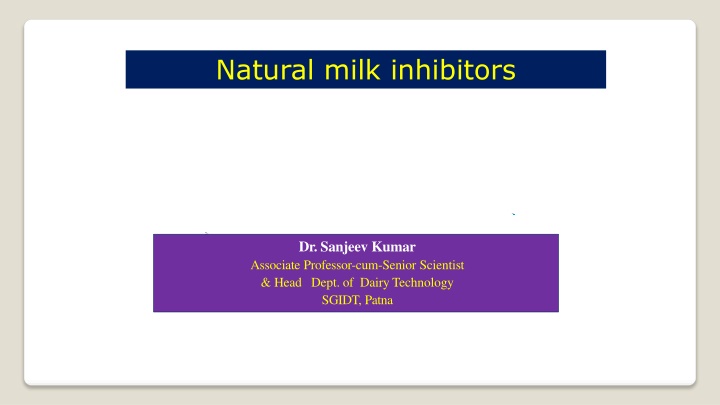
Natural Milk Inhibitors and Preservatives
Discover the role of natural milk inhibitors like immunoglobulins, lactoferrin, and lysozyme in providing immunity against pathogens. Learn about their functions, sources, and benefits in maintaining milk quality and inhibiting bacterial growth. Explore how these components contribute to overall health and well-being.
Uploaded on | 2 Views
Download Presentation

Please find below an Image/Link to download the presentation.
The content on the website is provided AS IS for your information and personal use only. It may not be sold, licensed, or shared on other websites without obtaining consent from the author. If you encounter any issues during the download, it is possible that the publisher has removed the file from their server.
You are allowed to download the files provided on this website for personal or commercial use, subject to the condition that they are used lawfully. All files are the property of their respective owners.
The content on the website is provided AS IS for your information and personal use only. It may not be sold, licensed, or shared on other websites without obtaining consent from the author.
E N D
Presentation Transcript
Natural milk inhibitors Dr. Sanjeev Kumar Associate Professor-cum-Senior Scientist & Head Dept. of Dairy Technology SGIDT, Patna
Natural preservatives inmilk Immnoglobulins Lactoferrin Lysozyme
Immunoglobulins Antibodies synthesized in response to stimulation by specific antigens Offers non-specific humoral immunity response to Gram ve enteric & respiratory bacteria Name IgA IgD Types 2 1 Description Prevents colonizationof bacteria Activate basophils and mast cells to produce antimicrobial factors Binds to allergens and triggers histamine release from cells and basophilesthat involved in allergenicreactions Provides the majority of antibody-based immunity against invading pathogens. The only antibody capable of crossing the placenta to give passive immunity to fetus. Eliminates pathogens in the early stages of Bcell mediated (humoral) immunity Buffalo colostrum: 76.2 g/ 100 g whey protein, Buffalo milk: 43.4 g/100g WP Cow colostrum: 40.1 g/ 100 g whey protein, Cow milk: 0.45 g/100g WP Confers a high degree of immunity as antibodies especially to the neonates IgE 1 IgG 4 IgM 1
Lactoferrin Lactoferrin is a Fe-binding globular glycoprotein is one of the components of the immune system of the body It has antimicrobial activity e.g., bacteriostatic, bacteriocidal and fungicide Antimicrobial activity results from its unsaturated Fe character, as it is only 5-30% saturated with Fe and removes Fe from the microbes Shown to inhibit the grown of food borne pathogens e.g., E. coli & S. aureus Product Cowmilk Cowcolostrum Buffalocoloustrum Buffalo milk Human milk Human colostrum mg/ml 0.10 0.70 0.75 0.32 10.0 1.0
Lysozyme Lysozyme, also known as muramidase or N- glycanhydrolase, are glycoside hydrolase enzymes acetylmuramide It damages bacterial cell walls by catalyzing hydrolysis of 1,4- -linkages between N- acetylmuramic acid & N- peptidoglycan and between N-acetyl-D-glucosamines in chitodextrins acetyl-D-glucosamine in a Lysozyme is abundant in a number of secretions e.g., human milk and mucus tears, saliva,
Lysozyme Bovine milk: 13 g/100ml Human milk 10-39 mg/100ml (3000 times more activity than bovine milk) Egg albumin is the richest source Lysozyme is a natural form of protection from pathogens like Salmonella, E.coli, and Pseudomonas Egg white lysozyme is used to prevent late blowing of cheese because it inhibits the growth of Clostridium tyrobutyricumspores
Effect of Pasteurization on antimicrobial components of milk Milk Component Bovine immunoglobulins Role in Milk Transfers immunity against bovinepathogens to calves; may provide some lactogenic immunity to the gut. Most immunoglobulins are carried in colostrum An Fe-binding protein, scavenger of Fe, thereby providinganti-bacterial effects by limiting the availability of free Fe required for bacterial proliferation Activeprimarilyagainst Gram +ve bacteria. In conjunction with lactoferrinhas bactericidal effects Effect of Pasteurization No loss in activity during batch pasteurization (62.7 C/30min), retains60- 70% activity after HTST pasteurization Lactoferrin Unheated and pasteurized lactoferrin have similar antibacterial properties Lysozyme Greater than 75% of activity retained after heating at 80 C/15sec
Limitations of Practical Application of Natural Preservatives None of the three natural preservatives could be used in practical conditions for mass preservationof milk: Present in very small quantities in milk Unavailability in largequantities Expensive fractionation methods Specific against bacterialaction Ineffective when at high bacterial load During the last decades research was concentrated to combine chemical preservation with naturally occurring bio-protective factors Lactoperoxidase/ thiocyanate/ hydrogen peroxide system (LP-s)



